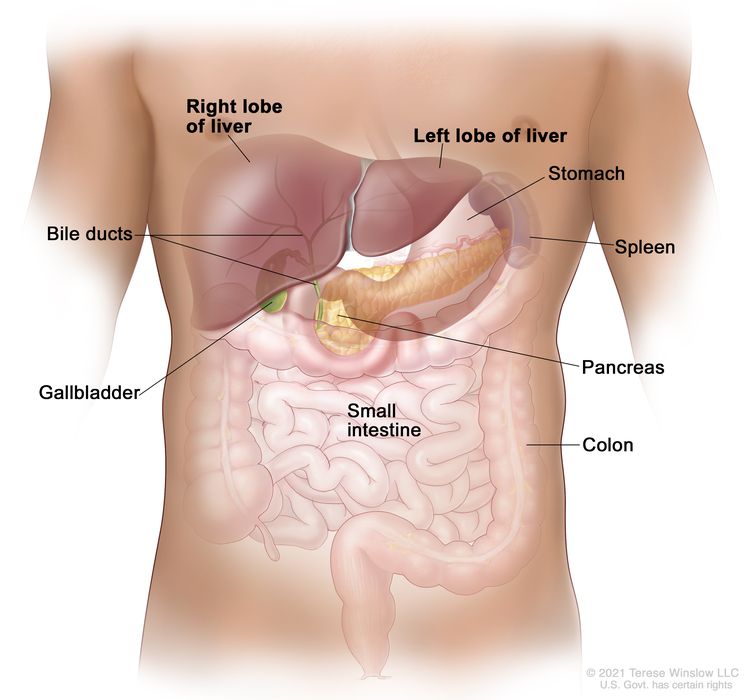Liver Cancer
Because of a lapse in government funding, the information on this website may not be up to date, transactions submitted via the website may not be processed, and the agency may not be able to respond to inquiries until appropriations are enacted.
The NIH Clinical Center (the research hospital of NIH) is open. For more details about its operating status, please visit cc.nih.gov.
Updates regarding government operating status and resumption of normal operations can be found at opm.gov.
Primary liver cancer is a disease in which malignant (cancer) cells form in the tissues of the liver. Cancer that forms in other parts of the body and spreads to the liver is not primary liver cancer. The liver is one of the largest organs in the body. It has two lobes and fills the upper right side of the abdomen inside the rib cage. The main functions of the liver include the following:
- to make bile to help digest fat that comes from food
- to store glycogen (sugar), which the body uses for energy
- to filter harmful substances from the blood so they can be passed from the body in stools and urine
 Anatomy of the liver. The liver is in the upper abdomen near the stomach, intestines, gallbladder, and pancreas. The liver has a right lobe and a left lobe. Each lobe is divided into two sections (not shown).
Anatomy of the liver. The liver is in the upper abdomen near the stomach, intestines, gallbladder, and pancreas. The liver has a right lobe and a left lobe. Each lobe is divided into two sections (not shown). Hepatocellular carcinoma and bile duct cancer (cholangiocarcinoma) are the main types of adult primary liver cancer.
Most adult primary liver cancers are hepatocellular carcinomas. This type of liver cancer is the third leading cause of cancer-related deaths worldwide.
Primary liver cancer can occur in both adults and children. However, treatment for children is different than treatment for adults. For more information, see Childhood Liver Cancer.
These and other signs and symptoms may be caused by adult primary liver cancer or by other conditions. Check with your doctor if you have any of the following:
- a hard lump on the right side just below the rib cage
- discomfort in the upper abdomen on the right side
- a swollen abdomen
- pain near the right shoulder blade or in the back
- jaundice (yellowing of the skin and whites of the eyes)
- easy bruising or bleeding
- unusual tiredness or weakness
- nausea and vomiting
- loss of appetite or feelings of fullness after eating a small meal
- weight loss for no known reason
- pale, chalky bowel movements and dark urine
- fever
- Updated: May 15, 2024
If you would like to reproduce some or all of this content, see Reuse of NCI Information for guidance about copyright and permissions. In the case of permitted digital reproduction, please credit the National Cancer Institute as the source and link to the original NCI product using the original product's title; e.g., “What Is Liver Cancer? was originally published by the National Cancer Institute.”
Want to use this content on your website or other digital platform? Our syndication services page shows you how.
National Cancer Institute at the National Institutes of Health
The content on this page is originally published by the National Cancer Institute.
Click here to see the original content on their site.
